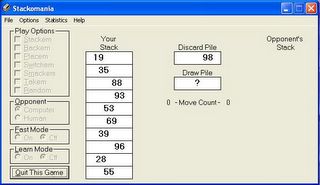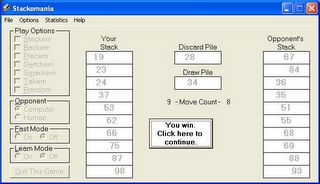Stackomania
Name: Stackomania
Author: Megalactic Enterprises
License: Freeware
Website: http://www.geocities.com/stackomania/
This week, I am writing about an odd little two-person strategy game. I realize that Stackomania will not appeal to everyone. In fact, it may only appeal to mathematicians and similarly aligned individuals.
Stackomania is played with a deck of 100 cards, numbered 1 to 100. To win you need to form a increasing series of 10 cards before your opponent does so. Each player starts with 10 randomly selected cards which are then ordered at random. Similar to gin rummy, each turn consists of choosing either the known last discard of your opponent or the unknown top card from the deck, replacing one of the cards in your hand (but not permuting them), and discarding the replaced card.

The strategy in Stackomania is quite interesting. First you mentally pick an increasing subsequence which will hopefully form the basis for your eventual winning hand. In the example in the screen shot, I would choose 19-35-53-69. Then you start filling in the gaps. Here is the eventual winning solution. As you can see, only 19 and 53 actually survived.

Next comes the question of how to fill in the gaps. With a two-wide gap, it is easy to decide which card to replace: leave the bigger gap. For example, with -20-98-99-40- in your hand and a 25 play, replace the 98 and leave a 15 wide gap instead of the 5 wide gap if you replaced the 99. With a three-wide gap, things get interesting. Based on a simulation, if the card to play is between 20% and 80% of the overall width, place it in the middle. For example with -20-97-99-98-40- in your hand and a 24 to 36 to play, replace the 99. With wider gaps, it gets even more complicated. For an extra edge, you can keep track of which cards have played.
Another thing to keep your eye out for are two-way configurations like -10-30-20-40-. This is a good thing. With a 11 to 19, you can replace the 30; with a 31 to 39, you can replace the 20. Either way you complete the 10 to 40 sequence.
There is a fair bit of luck involved, but with a little practice, you can beat the computer more often than it beats you. I win about 65% of the time. Some of this is just from the fact that the human player always goes first. This brings me to my one complaint. I think the second player should get one last move after the first player completes their stack. If they complete their stack, the game is declared a draw.
After you master the basic game, there are several options to try. Stackem: 20 long stack instead of 10. Backem: stacks in decreasing order are also a win. Placeme: you see your initial cards one at a time and place them in your stack (I don't like this option). Switchem: you get to switch two cards in your stack after the initial cards are dealt. Smackem: allows you switch two cards in your opponents stack. Takem: allows you take a card from your opponent's stack at some point in the game. These options add some depth to the game.

0 Comments:
Post a Comment
<< Home